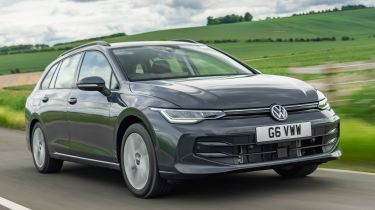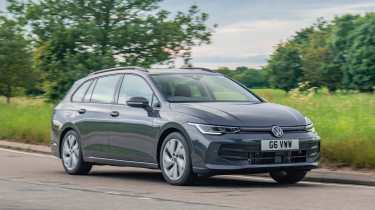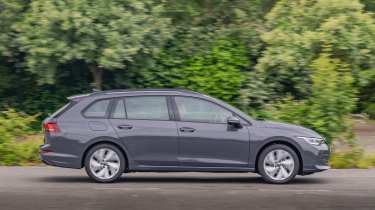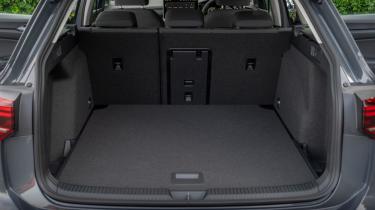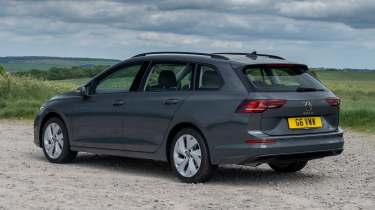Volkswagen Golf Estate review
The classy Volkswagen Golf Estate is still a desirable choice, even if it isn’t the most practical in its class

Is the Volkswagen Golf Estate a good car?
The Volkswagen Golf Estate is certainly on its way back to being at its best with the Mk8.5, which corrects many of the flaws of the pre-facelift model. It retains the model’s enviable ability of being classy yet classless, while a wide range of trim levels and powertrains mean there’s a Golf for every taste and budget.
However, while the Golf Estate is accomplished dynamically, it’s still not the last word in practicality – which is surely what a wagon should be all about. It loses points for not being available with the hatchback version’s plug-in powertrain option.
|
Key specs | |
|
Fuel type |
Petrol and diesel |
|
Body style |
Five-door compact estate |
|
Powertrain |
1.5-litre 4cyl turbocharged petrol, front-wheel drive |
|
Safety |
5 stars Euro NCAP (2022) |
|
Warranty |
3 years/36,000 miles |
How much does the Volkswagen Golf Estate cost?
Few car names are as easily recognised as ‘Golf’. VW’s family-friendly model celebrated its 50th birthday in 2024, and in the five decades it has been in production, more than 37 million examples have found homes. The appeal of the standard hatchback versions was boosted further with the arrival of a practical estate version not long after the launch of the Mk3 model in 1991 – and there’s been a load lugger in the line-up ever since.
Under the skin, the Golf Estate is based on the latest Mk8.5 version of the hatch, which is very closely related to the Mk7 that debuted in 2012. That means it features the MQB Evo platform that underpins various other VW Group cars, including the SEAT Leon Estate and Skoda Octavia Estate.
Used - available now

2020 Suzuki
SX4 S-Cross
46,548 milesManualPetrol1.4L
Cash £11,997
2020 BMW
X2
44,368 milesAutomaticPetrol2.0L
Cash £14,997
2021 SEAT
Ibiza
18,736 milesManualPetrol1.0L
Cash £14,897
2023 Land Rover
Discovery
13,183 milesAutomaticDiesel3.0L
Cash £57,500Volkswagen’s trim structure for the Golf hatchback is almost bewilderingly large, so it’s good that the estate has a slimmed-down line-up. At the entry point is the Life, followed by mid-range Style, R-Line and Black Edition variants. Unlike the hatchback there’s no sportier GTI or plug-in eHybrid or GTE versions. However, you can get the hot R and R Black Edition in estate form, making your trip to the tip infinitely quicker.
Entry-level Life trim offers a generous amount of kit and tech, including a digital instrument display, wireless smartphone charging and a 13-inch colour touchscreen. The latter is standard on every model and means that the climate controls are now permanently displayed across the bottom of the screen.
The Style model should prove popular, adding items such as larger 17-inch alloy wheels and sports seats with upgraded upholstery, while the dynamic R-Line spec includes lowered, stiffer suspension and an exterior styling pack giving a more muscular stance. The Black Edition is around £1,000 more than an R-Line and adds larger wheels, matrix LED headlights, heated front seats and more.
Prices for the Golf Estate start at just under £29,000 for the 1.5 TSI Life, rising to around £45,000 for the scorching hot R version.
Engines, performance & drive
When it was launched, the eighth-generation Volkswagen Golf Estate had one or two flaws, but a lack of choice in its range was certainly not one of them. It’s not quite as diverse as its hatchback cousin, but buyers will still need some time to pore over the brochures and online configurator before making their decision. For starters, there’s a number of powertrains to choose from, including (whisper it) some diesels.
The entry-level petrol is a 1.5-litre four-cylinder TSI. This motor produces either 114bhp and 220Nm or 148bhp and 250Nm, depending on the model. Models fitted with the seven-speed DSG automatic (a six-speed manual is standard) get an eTSI badge to reflect the addition of mild-hybrid tech that includes an electric motor to take some load off the engine when accelerating. An unobtrusive cylinder deactivation system is also standard, shutting down two of the four cylinders when cruising to save fuel.
Regardless of power output, the four-cylinder 1.5-litre petrol is a smooth, responsive and refined unit that’s well suited to the Golf Estate. The entry-level 114bhp unit manages a 0-62mph time of 9.9 seconds, while the more powerful 148bhp 1.5 TSI has a 0-62mph time of 8.5 seconds.
Diesel still has its places in a practical estate car, and for the Golf Estate, there’s a 2.0-litre unit, with outputs of 113bhp and 300Nn and 148bhp and 360Nm – the latter with an automatic gearbox. The lower-powered version is good for 0-62mph in 10.5 seconds, while the more powerful unit needs just 8.4 seconds. Both versions offer effortless mid-range torque and decent real-world pace.
Undoubtedly, the most important quality of a family estate driving experience is its ease of use, and more than ever, the Golf is a car anyone can hop into and immediately feel comfortable with. The Golf’s steering is nicely weighted and fairly precise, and while it isn’t the quickest or brimming with feedback, it gives the car an easy familiarity that makes it a confidence-inspiring choice on twisting back roads.
While some rivals handle more sharply on smooth surfaces, the Golf’s set-up is very well judged for Britain’s bumpy roads. The balance is impressively neutral, and grip, especially on the front axle, is strong for the
One of the VW Golf’s strengths has always been to offer a chassis compromise that delivers decent body control through corners without letting the ride comfort fall apart on a bumpy road. Those characteristics continue with the updated Mk8.5; it’s not the firmest model in its class by a long stretch, but there’s sufficient control for big bumps to be dealt with in a single bounce of the springs.
Better still, the Golf combines this composure with excellent long-haul refinement. The quiet-riding Peugeot 308 SW is arguably a touch more hushed, but overall, the VW’s well-insulated cabin and high-speed stability make motorway journeys a doddle.
If you need to get you and your luggage to wherever you’re going as quickly as possible, there’s the flagship Golf R. Packing a hefty 329bhp punch from its turbocharged 2.0-litre petrol engine, this is the car you’ll need to win the space race. With four-wheel drive as standard and a quick-shifting seven-speed DSG transmission, the R can rocket from 0-62mph in just 4.8 seconds.
If anything, the go-faster Golf feels even faster in the real world, its muscular 420Nm of torque delivers crushing mid-range acceleration that makes mincemeat of slower traffic when overtaking. As you’d expect, there are various driver modes, one of which allows you to turn down the car’s irritating synthetically-generated sporty engine note when in the most dynamic settings.
Lowered and stiffened suspension, a trick-four-wheel drive system, and numerous driver modes mean the Golf R estate isn’t all power and no control. Adaptive dampers allow you to stiffen or soften the ride at the touch of a button (although it’s still quite firm, even in its comfiest setting), to suit the road and your mood.
There’s a limpet-like grip in the corners, while the steering has a meatier and more connected feeling. Engage the raciest R mode and the VW even serves up a little bit of rear-wheel drive-style throttle adjustability. Quite simply, few load luggers are as fast and entertaining when driving from point to point across challenging back roads.
|
Model |
Power |
0-62mph |
Top speed |
|
VW Golf Estate 1.5 TSI 115 Life |
114bhp |
10.2 secs |
126mph |
|
VW Golf Estate 2.0 TDI 150 Style |
148bhp |
8.4 secs |
139mph |
|
VW Golf Estate R |
328bhp |
4.8 secs |
155mph |
MPG, emissions & running costs
Over the years, Volkswagen has carefully positioned the Golf as a more upmarket alternative to mainstream rivals. However, the competition now plays the same game of injecting premium appeal into its cars, which means VW can no longer justify charging more for the Golf Estate, which now starts at around £28,000. For reference, an entry-level Vauxhall Astra Sports Tourer will cost a few hundred quid more.
And once on the move, this German estate car won’t cost a fortune to run, either. Officially, the 1.5 TSI petrol achieves 51.6mpg, which is a figure that would be tricky to match around town, but easy to match – or even beat – on more open roads. Even the more powerful 148bhp versions claim at least 50mpg. The petrol’s CO2 emissions range between 120g/km and 129g/km, depending on the model.
As you’d expect, the diesels are even more frugal, with the standard 114bhp 2.0-litre TDI promising an impressive 64.2mpg, while the more powerful 148bhp auto version of the same engine will return around 58.9mpg. You might not reach those numbers in everyday driving, but you certainly won’t be a regular at the fuel station. Emissions are cleaner, too, although not by as much as you’d think. The lower powered version emits a claimed 115g/km, while the 148bhp model’s figure is the same as the dirtiest petrol at 129g/km.
The least efficient model is the flagship Golf R, which due to its fire-breathing turbocharged 2.0-litre claims 33.2mpg at the pumps and emits 185g/km of CO2. It’s also the only Golf with a price tag that breaches the £40,000 mark, meaning owners will have to pay an extra £410 above the standard vehicle excise duty (VED) per year for the car’s first five years.
Unlike its hatchback cousin, the Golf Estate isn’t available with a plug-in hybrid powertrain, which means company car users are in for a more expensive work perk. As a result, the most cost-effective model for user choosers is the entry-level Life 1.5 TSI, which is rated for Benefit-in-Kind tax at 29%, meaning a lowest annual tax bill of nearly £1,700. By contrast, the rapid Golf R will set the same user back over £3,000
How much you pay for insurance will depend on the model. The entry-level Golf Life 1.5 TSI starts from a reasonable group 17 insurance, while the high-performance Golf R is rated in group 33.
Such is the demand for used Golf models that they normally hold onto their values fairly well The petrol options hold their value best, with the numerous variants of the 1.5 TSI clinging on to roughly 47 per cent of their original price after three years or 36,000 miles. The diesel models aren’t far behind, with the base Life versions retaining as much as 45 per cent over the same time period and mileage. The worst versions for depreciation are the high-performance R models, which commonly are worth only around 40 per cent of their new value when it’s time to trade it in.
|
Model |
MPG |
CO2 |
Insurance group |
|
VW Golf Estate 1.5 TSI 150 Style |
64.2 |
115g/km |
18 |
|
VW Golf Estate 2.0 TDI 115 Life |
49.6-51.4 |
125-129g/km |
18 |
|
VW Golf Estate R |
33.2 |
185g/km |
33 |
Design, interior & technology
Constantly honed over 50 years, the Golf remains a familiar and easily recognised sight on the roads. As with all the various generations, VW has taken an evolutionary approach to the latest MK8.5, its thinner front grille and narrow headlights being the most obvious change over its predecessor. It’s a stylish and understated design, but it’s lost some of the tautness of the handsome Mk7 model.
Entry-level cars benefit from 16-inch alloy wheels, rain-sensing wipers, and LED headlights. Wireless Android Auto and Apple CarPlay connectivity are standard.
Stepping up to Style trim brings some chrome exterior trim and a funky LED light strip running across the top of the radiator grille. The R-Line versions get a sporty styling pack and rear privacy glass.
At the top of the range is the racy R, which gets enhancements such as figure-hugging sports front seats, keyless entry, and model-specific interior and exterior trim. There’s also plenty of trademark blue stitching and numerous R logos to remind occupants they’re in the fast flagship estate.
Inside, VW has updated the dashboard with enhanced touchscreen tech. The Digital Cockpit Pro set-up is now standard, while the infotainment screen gets a larger 13-inch screen.
VW has also made other changes to make the Golf more user-friendly. For example, the fiddly touch-sensitive steering wheel controls have been replaced by physical buttons on the spokes, making them far more intuitive to use.
However, the main volume control for the audio is still an awkward touch-sensitive slider below the touchscreen. On the plus side, it’s backlit now, so it can be used in the dark, plus it's a little more responsive than before. However, this slider, along with the ones on either side for temperature control, are still positioned where you are likely to rest your hand when using the main touchscreen, meaning inadvertent audio volume and temperature adjustments.
One area that hasn't been addressed as part of the update is quality. The Golf still feels a cut above many rivals, but like the older MK8, there are still a number of cheaper feeling plastics and a sense the car has been built down to a price. It’s all fairly well constructed, but buyers trading up from an MK7 or 7.5 are likely to feel a little shortchanged.
Sat-nav, stereo and infotainment
All Mk8.5 Golfs have the brand’s 13-inch Discover touchscreen infotainment system, and while it doesn’t quite sit as neatly on the dash as the previous Mk8’s smaller screen, in terms of its usability, it’s a step up from the unit it replaces.
Not only does the latest system have faster loading times and a more intuitive menu layout, but its larger screen means that the climate controls are now on permanent display at the bottom of the screen. While we’d still rather have physical controls to make quick adjustments to the temperature, the revised set-up is much better than before.
Many of the Golf’s driver-assistance systems have been tweaked. These include the Park Assist function, which can now detect if a space is large enough for the car as it drives beside it. If it is, the VW can drive itself into the bay by adjusting the drive and steering. Moreover, depending on the model, owners can park the car remotely using a smartphone app – they simply stand outside the car and let the tech do the rest. A 360-degree camera system is available as a £600 option on entry-level Life trim if you prefer DIY parking but would like to have a better view of your immediate surroundings.
Boot space, comfort & practicality
The Golf grew a few centimetres when it changed from the MK7 to the MK8, but this MK8.5 update retains the same external dimensions as the earlier car. That means the five-door estate stretches the tape measure at 4,631mm long, 1,789mm wide (excluding door mirrors), and 1,487mm in height. Overall, it’s around 150mm longer than the standard hatchback and a fraction shorter, but in all other respects, it takes up pretty much the same space on the road.
Climb aboard, and you’ll discover the Golf gets the basics right. The driving position is spot on, and the wide amount of adjustment in both the front seat and the steering wheel makes it easy for most people to get comfortable behind the wheel. The large glass areas, plus the ability to raise the seat up high if necessary, meaning that all-round visibility is better than in most rivals.
There are some well-thought-out storage areas, from the large glovebox to a dedicated smartphone slot complete with wireless charging. The latter is angled so that your device can’t fall out of place while driving. The door bins are large and are carpeted both front and rear to stop items from rattling about. They also contain holders for larger 1.5-litre bottles.
In the back, adults will find a reasonable amount of kneeroom compared with most rivals, while the flat roofline means that even taller people have space above their heads. The outer seats are quite sculpted, and are a little more upright than in other rivals. If you need to squeeze three people in the back, then the middle seat occupant will have to straddle a high central tunnel.
Still, storage is good, with map pockets and smaller smartphone pouches stitched into the back of the front seats. There’s also a handy fold-down central armrest that features a pair of cup-holders.
A pair of ISOFIX child seat mounting points are provided on the outer positions of the rear bench seats and the front passenger seat. The hooks in the back are hidden behind some easily removable plastic tabs.
The recent updates have done nothing to alter the Golf Estate’s carrying capacity, which remains good but not the very best. The luggage area measures 611 litres with the rear seats in place, and 1,642 litres with the second row folded down – figures that beat the likes of Vauxhall’s Astra Sports Tourer but falls short of the Octavia’s.
At least the Golf Estate has a variable-height boot floor, which means you can maintain a flat load bay even when you’ve folded down the second row. In addition, there are useful hooks and tie-down points that help maximise the use of the space on offer.
Due to their practical nature, estate cars are often called upon to pull caravans and trailers - and the Golf will be no different. In the lower-powered 114bhp petrol, you’ll be restricted to a limit of 1,300kg for a braked trailer, while the 148bhp 1.5-litre TSI and 114bhp 2.0-litre TDI diesel have a higher 1,500kg rating. The most powerful 148bhp diesel has the greatest pulling power, with an ability to haul up to 1,600kg. A retractable tow hitch with an electric release is available for just under £800.
|
Dimensions | |
|
Length |
4,631mm |
|
Width |
1,789mm |
|
Height |
1,487mm |
|
Number of seats |
5 |
|
Boot space |
611-1,642-litres |
Safety & reliability
The Golf has always had a strong reputation for safety and dependability - and the Mk8.5 pretty much lives up to the car’s legacy. It comes with plenty of standard safety kit, including adaptive cruise control, a driver fatigue detection system, a road sign recognition system and an autonomous braking feature.
It also features Volkswagen’s advanced Car2X driver assistance system. This state-of-the-art set-up wirelessly communicates with other similarly-equipped vehicles, warning drivers of problems such as roadside hazards, vehicle breakdowns, and vehicles ahead that have applied emergency braking. The system also uses the information it receives to detect when the end of a traffic jam is coming up, and is then able to re-engage the car’s adaptive cruise control once the traffic clears. It's a clever piece of kit, but only a limited range of vehicles currently has it fitted, meaning it’s not quite as useful yet as it could be.
Euro NCAP tested the structurally identical hatchback Golf MK8 in 2019, before reassessing it in 2022 under its more rigorous safety testing procedures. In both instances, it received a top five-star rating, which is much better than the Peugeot 308 (and its Peugeot 308 SW estate derivative), which achieved four stars out of five.
VW has long held a reputation for reliability and owner satisfaction, so the Golf’s last place finish in the 2024 Driver Power survey will come as a shock. Owners were unhappy with numerous aspects of their cars, with the majority of issues surrounding the infotainment system, and the mix of touchscreen and physical controls. However, the updated Golf’s much-improved touchscreen set-up hopefully addresses many of these issues.
Work still needs to be done to improve the Volkswagen brand’s poor 29th place out of 32 in the best manufacturers category of the survey – a further slip from the 27th place result the brand received in 2023. According to our expert data, 23.4 per cent of Volkswagen owners polled experienced a fault of some sort during the first year of ownership.
As with all its models, Volkswagen offers a three-year, 60,000-mile warranty package with the Golf. It’s a fairly standard guarantee, but it does seem a little stingy compared to the five- to seven-year warranty packages offered by rivals such as Cupra (one of Volkswagen’s stablemates) Hyundai, Kia, and even Toyota. VW does offer extended cover for extra cost, though.
The Golf is available with a two-year servicing package for around £500. The cost of the most basic oil-change service beyond that is around £250, which means three years of maintenance will set you back around £750.
Volkswagen offers a choice on how your vehicle is maintained, with fixed (time) and flexible (mileage) servicing options available. The former is better suited to lightly used cars with a low annual mileage, while the latter is designed for harder-working machines that are frequently racking up plenty of long motorway journeys.
What do owners think?
Here’s what owners in the 2024 Driver Power survey thought of the VW Golf. These impressions are of the Mk8 car rather than the revised Mk8.5 version covered in this review.
|
What they like |
What they don’t like |
|
“I can drive 680 miles in one day on a round trip to Devon, and I am not stiff or sore when I get back.” |
“Disappointing quality. I expected better of VW and would not buy another Golf based on this one.” |
|
“I love how comfortable and smooth a drive it is. It looks beautiful and the petrol costs are sensible.” |
“The touchscreen is almost impossible to use safely while the car is in motion. It needs more switches.” |
|
“A reasonably serene ride when I’m just going from A to B. It goes like the clappers when I’m in the mood.” |
“I tend to use my phone because the Golf’s built-in navigation seems to take longer routes.” |
|
“I find the much-maligned infotainment works really well if you set it up properly with shortcuts in the menu.” |
“Luggage space is all right, but it can be a bit of a squeeze in the back seats if passengers have long legs.” |
|
“The boot is very accommodating. There’s enough space is for a family to go on holiday. Even better, we can bring our dog along, too. |
“I had two Golfs before my Mk8; each provided years of trouble-free motoring. This one is a joke in comparison.” |
|
“My Golf offers a good balance between pin-sharp handling and limousine-like comfort. VW has struck just the right balance for me; it’s good to drive and comfortable.” | |
|
“There’s a good amount of height and lumbar adjustment, and the bolsters give lots of support. The controls and switches are very user-friendly as they respond easily.” | |
|
“The quality is good. I’ve driven many other cars, so I can appreciate the Golf’s fit and finish.” | |
|
“It’s a great car in terms of style, performance, space and practicality, and the residuals will be strong.” |
Tell us what you think of your car! Take the Driver Power survey…
Volkswagen Golf alternatives
As we’ve already seen, the VW Golf not only faces competition from rival manufacturers, but also from the closely-related SEAT Leon and Skoda Octavia. Of the home-grown competition, the Skoda literally presents the biggest threat. With its vast 640-litre boot and plenty of cleverly thought-out storage, the Czech machine is one of the best compact load luggers in the business.
Other challengers include the Peugeot 308 SW and Vauxhall Astra Sports Tourer. Like the VW Group cars, these two share a similar platform and serve up near identical performance and space to each other. However, both score with company car users because the Golf Estate isn't available with plug-in hybrid and fully electric powertrains alongside more traditional internal combustion engine (ICE) options.
Frequently Asked Questions
The Golf Estate’s hatchback cousin slumped to the bottom of our Driver Power ratings in 2024, with owners particularly frustrated with the car’s infotainment.
